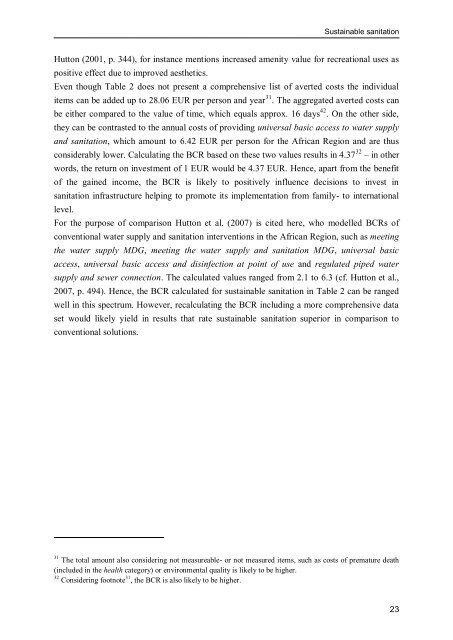Economic Effects of Sustainable Sanitation - SuSanA
Economic Effects of Sustainable Sanitation - SuSanA
Economic Effects of Sustainable Sanitation - SuSanA
You also want an ePaper? Increase the reach of your titles
YUMPU automatically turns print PDFs into web optimized ePapers that Google loves.
<strong>Sustainable</strong> sanitation<br />
Hutton (2001, p. 344), for instance mentions increased amenity value for recreational uses as<br />
positive effect due to improved aesthetics.<br />
Even though Table 2 does not present a comprehensive list <strong>of</strong> averted costs the individual<br />
items can be added up to 28.06 EUR per person and year 31 . The aggregated averted costs can<br />
be either compared to the value <strong>of</strong> time, which equals approx. 16 days 42 . On the other side,<br />
they can be contrasted to the annual costs <strong>of</strong> providing universal basic access to water supply<br />
and sanitation, which amount to 6.42 EUR per person for the African Region and are thus<br />
considerably lower. Calculating the BCR based on these two values results in 4.37 32 – in other<br />
words, the return on investment <strong>of</strong> 1 EUR would be 4.37 EUR. Hence, apart from the benefit<br />
<strong>of</strong> the gained income, the BCR is likely to positively influence decisions to invest in<br />
sanitation infrastructure helping to promote its implementation from family- to international<br />
level.<br />
For the purpose <strong>of</strong> comparison Hutton et al. (2007) is cited here, who modelled BCRs <strong>of</strong><br />
conventional water supply and sanitation interventions in the African Region, such as meeting<br />
the water supply MDG, meeting the water supply and sanitation MDG, universal basic<br />
access, universal basic access and disinfection at point <strong>of</strong> use and regulated piped water<br />
supply and sewer connection. The calculated values ranged from 2.1 to 6.3 (cf. Hutton et al.,<br />
2007, p. 494). Hence, the BCR calculated for sustainable sanitation in Table 2 can be ranged<br />
well in this spectrum. However, recalculating the BCR including a more comprehensive data<br />
set would likely yield in results that rate sustainable sanitation superior in comparison to<br />
conventional solutions.<br />
31 The total amount also considering not measureable- or not measured items, such as costs <strong>of</strong> premature death<br />
(included in the health category) or environmental quality is likely to be higher.<br />
32 Considering footnote 31 , the BCR is also likely to be higher.<br />
23

















